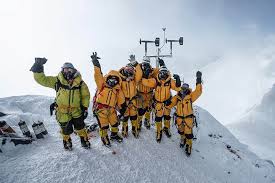World’s Highest Weather Stations installed on Mt Everest
The National Geographic Society (NGS), a US based non-profit scientific and educational organizations announced successful installation of world’s highest operating weather stations on Mount Everest. This installation was part of National Geographic and Rolex’s Perpetual Planet Extreme Expedition to Everest.
Key Highlights
Climate scientists and the multi-disciplinary team created the history by installing world’s highest operating weather station at Mount Everest’s Death Zone, some other automated stations on other parts of the mountain.
Station Locations: These world’s two highest operating automated weather stations (a 7-foot- building) were installed at Balcony area (8,430 m) and South Col (7,945 m)that can withstand extreme winds and cold weather. Three other weather stations were also placed on Mount Everest at Camp II (6,464 m), Everest Base Camp(5,315 m) and Phortse (3,810 m).
Balcony area weather station is first weather station installed at elevation of more than 8,000 metres thus it will also be 1st to sample stratosphere. It is significant as natural variations in atmospheric boundaries change over time.
Functions: It will provide researchers, climbers, and public with near real-time information about mountain conditions. Each weather station will record data on temperature, relative humidity (amount of water vapour present in air), barometric pressure, wind speed, as well as wind direction. They will also give scientists direct observations to understand jet stream, and will help them understand how the Himalayas are getting affected by climate change. Data so collected from these weather stations will help communities respond to climate risks that threaten lives and livelihoods of more than 1 billion people in region.
Significance: The stations installation is aimed at breaking new grounds in monitoring and understanding of climate change as they will help continuously monitor upper reaches of atmosphere (such as stratosphere), which is critical to tracking and predicting weather patterns around the world.
National Geographic and Rolex’s Perpetual Planet Extreme Expedition to Everest
It was multipurpose scientific expedition held from April to June 2019. It was most comprehensive single scientific expedition to mountain in history. It included International team of scientists, climbers and story-tellers, led by researchers from National Geographic Society (NGS) and Tribhuvan University in Nepal and supported in partnership with Rolex.
The series of experiments that were part of expedition included collecting ice core samples (at 8020 metres) from highest point ever and performing a helicopter-based LIDAR scan from most extreme height ever accomplished.
Month: Current Affairs - June, 2019


